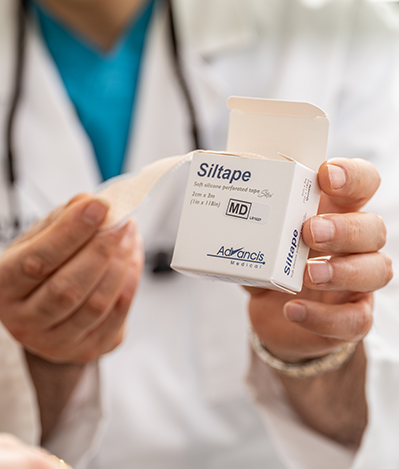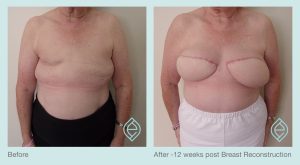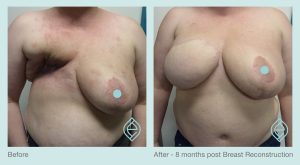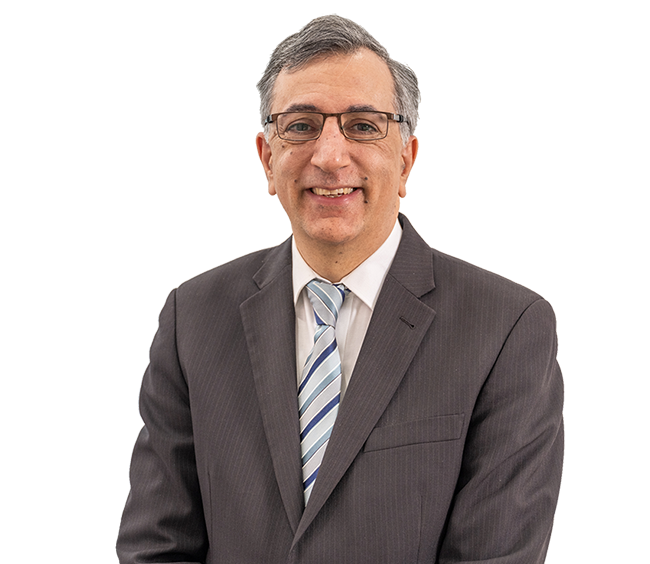Procedure Spotlight
- Aimed at re-creating the breasts after mastectomy
- Can be done using patient’s own tissue (autologous) or using implants (alloplastic)
- Breast reconstruction can be performed at the same time as the mastectomy (immediate) or after all breast cancer treatments are complete (delayed)
Unfortunately, many women lose their breasts to breast cancer. In Australia, breast cancer affects 1 in 8 women. For many, treatment of breast cancer involves a mastectomy or lumpectomy. The aim of breast reconstruction is to re-create the breast in these patients, which is an important step in restoring their sense of femininity.
Breast reconstruction, although rewarding, can be quite a complex procedure.

This is one of Dr Safvat’s areas of interest and he frequently performs breast reconstruction surgery.
Technique
One of the most important decisions regarding breast reconstruction surgery is the timing and the type of reconstruction. There are many factors that influence this, including type of breast cancer, the treatment(s) required for the cancer, the patient’s body shape, the size of the reconstruction and the patient’s preference. The decision is ultimately made by the patient following a thorough discussion with Dr Safvat about all the available options.
Breast reconstruction can be done using the patient’s own tissues (autologous) or using implants (alloplastic). At times it may be necessary to combine both of these methods to get the best breast reduction result for the patient.
Both have advantages and disadvantages and will be discussed in detail in the first consultation with Dr Safvat. For example, autologous reconstruction avoids the need for implants, and as such the breast may feel and behave more naturally. However, it is more complex than alloplastic breast reconstruction and the recovery time is usually significantly longer.
Alloplastic reconstruction usually requires two operations. The first stage is to insert an expander that is slowly expanded with saline over a period of weeks to months. Once the desired size is achieved, it is replaced with a permanent silicone breast implant and the position is fine-tuned. The operation is simpler, of shorter duration, and requires less time to recover than other types of breast reconstruction such as autologous.
Autologous breast reconstruction most commonly uses the patient’s own abdominal tissues (the Transverse Rectus Abdominus Myocutaneous (TRAM) or the Deep Inferior Epigastric Perforator (DIEP) flaps, which offer the added advantage of giving the patient an Abdominoplasty / tummy tuck at the same time). Other tissues can also be used, depending on the patient’s body shape and wishes, including the buttock or back area.
Once the new breast has been reconstructed into its final shape, the nipple is created using local skin flaps and the areola with medical tattooing. Often, the opposite breast may need adjusting at that time in order to achieve symmetry. It may need to be lifted, reduced or augmented by your plastic surgeon.

Timing
Breast reconstruction can be performed at the same time as the mastectomy (immediate) or after all breast cancer treatments are complete (delayed). Depending on the type of reconstruction, the procedure often involves multiple stages – from creating a breast mound and adjusting the shape and symmetry to reconstructing a nipple and areola.
If immediate, the mastectomy and the reconstruction are performed using the same anaesthetic and hospital stay. Even though this makes the surgical procedure much longer, the patient wakes up with a reconstructed breast mound already in place and is spared the experience of not having a breast.
The decision to do an immediate or delayed breast reconstruction is not only based on patient preference but is also dependent on what other breast cancer treatments are needed. For example, if post-operative radiotherapy is needed, it will compromise the final result of an immediate reconstruction. Reciprocally, the breast reconstruction may interfere with these potentially life-saving treatments.
Dr Safvat will work closely with breast cancer surgeons to obtain the best possible cancer treatment as well as optimal reconstruction results.
Recovery
Dr Safvat performs breast reconstructions under general anaesthetic in fully accredited Sydney hospitals.
For autologous reconstruction, which is a bigger procedure and recovery, the patient will usually need to be monitored closely and spend a week or so in hospital. They will then need to spend a few weeks at home resting and recovering. There will be swelling and bruising for 4-6 weeks after a breast reconstruction and patients need to wear a compression garment during this time. Strenuous activity and heavy lifting are not allowed for at least 6 weeks following the surgery, however, walking is actively encouraged.
For Alloplastic reconstruction, the patient may only need to stay in hospital for a night or two and in some cases just for the day.

You will need about a week at home to recover and strenuous activity and heavy lifting are to be avoided for at least 6 weeks following surgery. A surgical garment will need to be worn for 4-6 weeks following surgery.
Preparation
Smoking and being overweight have been shown to cause significant complications after any surgery including Breast Reconstruction. Dr Safvat will insist that you stop smoking a minimum of 3 weeks before your surgery. Ideally you should be in the normal BMI range before your surgery and be overall well and healthy.
Scars
There is no way to prevent scars completely after surgery and everyone can scar differently. However, the techniques Dr Safvat uses to suture his wounds are designed to minimise scarring. What’s more, any scarring will fade over time, especially if they are cared for correctly.
Dr Safvat will provide you with his specific protocol for scar management that will help you protect and care for your incisions in a way that will minimise scarring.
Dr Safvat will also include LED Light Therapy sessions (available in Miranda only) which will assist with wound healing, scarring and recovery.
Patients who have followed Dr Safvat’s protocol for scar management diligently have been very pleased with their progress in reducing and fading of scars.

Complications
While all care and diligence is taken by Dr Safvat to minimise or avoid complications, any surgical procedure can be associated with some general complications and/or specific complications related to the surgery you are having. Choosing a Specialist Plastic Surgeon such as Dr Safvat and having your procedure done in an accredited hospital minimises risks as does using an accredited Anaesthetist.
Some general surgical potential complications are:
• Infection that may require antibiotics (Dr Safvat prescribes all patients antibiotics after surgery to minimise this risk).
• Fluid build-up under the skin (seroma).
• Allergic reaction to dressings and other items used during the procedure.
• The formation of blood collection (haematoma) which could require additional surgery.
• Scars heal differently in different people. Some people are genetically prone to develop keloid scars. Hypertrophic scars develop when there is a complication in the healing process. Whilst not ideal, there is no threat to your health if you develop these.
Some potential complications related to Breast Reconstruction surgery specifically are:
Alloplastic:
• Asymmetry
• Capsular Contracture (if implants are used)
• Rupture of implants due to trauma
• Changes in sensation to the breast
• BIA-ALCL (breast implant associated Anaplastic Large Cell Lymphoma)
Autologous:
• Loss of blood circulation to the reconstructed breast (causing total reconstruction loss)
• Fat necrosis (causing partial reconstruction loss)
• Asymmetry
• Changes in sensation to the breast
Cost
Breast Reconstruction surgery has a Medicare item number and patients should get a rebate from Medicare and their health fund (where applicable). The hospital costs are usually covered by private health funds depending on the patient’s level and type of coverage. Alternatively, you can have the procedure done in a Private Hospital as a Self-Funded patient.
Breast reconstruction can also be done in a public hospital under Medicare but there are waiting times that apply. Dr Safvat currently does not work in a public hospital.
Detailed information regarding costs will be provided to you after your initial consultation.
Frequently asked questions
Is Breast Reconstruction Surgery the right choice for me?
Breast Reconstruction surgery is a personal choice. It is not for everyone and a decision should not be made in a rush. Also the type of reconstruction is a personal choice and different for everyone. Generally, you should be in a normal BMI range and have realistic expectations about the outcome of the surgery.
WHAT YOU NEED TO DO BEFORE THE OPERATION?
Safvat will insist that patients stop smoking at least 3-4 weeks before their surgery. As a general rule, if a patient’s weight is stable, the result of the breast reconstruction surgery is better and more predictable. This is because the reconstructed and native breasts increase or decrease in size with a patient’s weight. All surgery preparation recommendations are covered during your consultation at Ethique Plastic Surgery – Miranda, Bowral or Concord rooms.
HOW MUCH SCARRING CAN I EXPECT AFTER BREAST RECONSTRUCTION?
Scarring is a natural part of the healing process and should be expected after breast reconstruction surgery. For the first three months, the incision sites will appear swollen and red. Gradually, the incisions will settle and scarring will start to fade. especially if they’re cared for correctly. Dr Andre Safvat at Ethique Plastic Surgery will show you how to care for your incision sites so that you can keep any scarring to a minimum. After about 12 months, your scars will appear much lighter and smaller.
DO I NEED TO INSERT IMPLANTS IN MY OTHER BREAST DURING BREAST RECONSTRUCTION SURGERY?
Breast implants are an option and will give you a much fuller result, but implants are not the only option. Patients can also choose to transfer fat and tissue to augment the breasts to give them more shape. Dr Safvat will take you through both options during your consultation so that you can choose an option that meets your needs. Patients must keep in mind that implants eventually need to be replaced. In most instances, this is only 10 – 15 years later though.
WILL I NEED A REVISION PROCEDURE?
There is a good chance that you may need more than one surgery to achieve your desired breast reconstruction. Revision breast reconstruction procedures are generally scheduled to correct irregularities after the first surgery. If the revision surgery is done in stages, naturally, you should be prepared for more than one procedure. Most revision breast reconstruction surgeries are performed 3 months after the initial procedure.
WILL MY RECONSTRUCTED BREASTS SAG?
Even though the breasts are reconstructed, they are still susceptible to the effects of weight fluctuations, pregnancy and age. If implants are used, sagging is very minimal and only occurs much later in life. If only one breast was reconstructed, the natural breast may sag on its own and additional breast reconstruction or breast lift surgery may be required.
Can I breastfeed after breast reconstruction?
Unfortunately, you will not be able to breastfeed with the reconstructed breast as the breast tissue has been removed.
Before and Afters


You must be over 18 years to view Dr Safvat’s before and after image galleries
Dr Safvat is a fully qualified Specialist Plastic Surgeon. Every patient is unique and results may vary. Any surgical procedure carries risks which need to be discussed with your doctor to ensure you are fully informed and realistic outcomes have been explained. Before proceeding, you should seek a second opinion from an appropriately qualified health practitioner.
These photos are of actual patients of Dr Safvat. Each has given consent for the photos to be used by Dr Safvat only.
DR ANDRE SAFVAT (MED1155201)
Registered Medical Practitioner, Specialist Plastic Surgeon (specialist registration in Surgery – Plastic surgery).
Dr André Safvat – Specialist Plastic Surgeon
Renowned for his dedication to his patients, his attention to detail and impeccable outcomes, Dr Safvat’s unparalleled expertise is reflected in the quality, professionalism and dedication of every member of our team.


